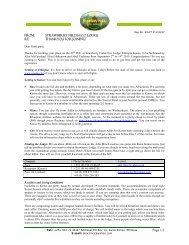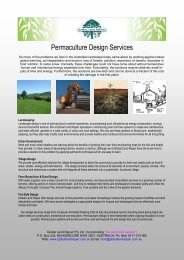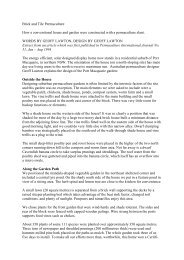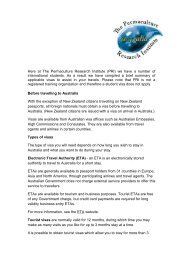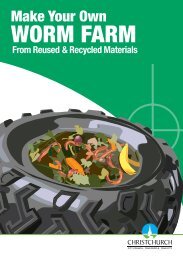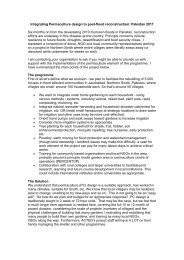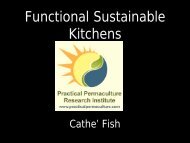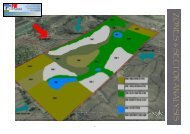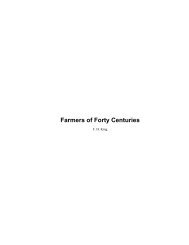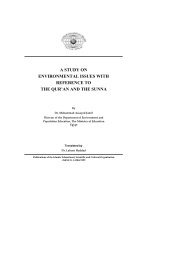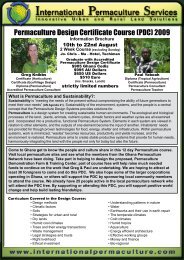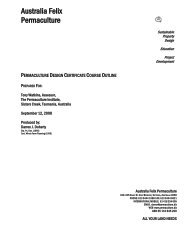Permaculture, a Beginners Guide - Garden Design Academy
Permaculture, a Beginners Guide - Garden Design Academy
Permaculture, a Beginners Guide - Garden Design Academy
Create successful ePaper yourself
Turn your PDF publications into a flip-book with our unique Google optimized e-Paper software.
<strong>Permaculture</strong>, a <strong>Beginners</strong> <strong>Guide</strong>“<strong>Permaculture</strong> offers a radical approach to food production and urban renewal, water, energyand pollution. It integrates ecology, landscape, organic gardening, architecture andagro-forestry in creating a rich and sustainable way of living. It uses appropriate technologygiving high yields for low energy inputs, achieving a resource of great diversity and stability.The design principles are equally applicable to both urban and rural dwellers” - Bill Mollison1 This page is from ‘<strong>Permaculture</strong>: A <strong>Beginners</strong> <strong>Guide</strong>’ by Graham Burnett
The Industrial Cup Of Tea...It’s become a cliche to say that we are living on the edge of eco-disaster. It’s also areality which cannot be overstated. The ecology of Gaia is an interface between land (theGeosphere), air (the Atmosphere), water (the Hydrosphere) and life (the Biosphere), adelicate web of interconnections formed over millions of aeons on the verge of unravellingbefore our eyes... If the earth’s 4.5 billion year history could be compressed into 30 days,life in the form of simple bacteria appeared on the tenth day whilst the first vertebratescrawled onto the land around the twenty fifth. Homo sapiens (peoplekind) appeared at about1 minute to midnight on the thirtieth. The industrial revolution would have happened withinthe last fraction of a second of that minute, yet within this instant, the face of the planet haschanged almost as much as within all the previous aeons.2 This page is from ‘<strong>Permaculture</strong>: A <strong>Beginners</strong> <strong>Guide</strong>’ by Graham Burnett
The <strong>Permaculture</strong> Cup Of Tea...The Eco-crisis is largely a consequence of the way that we in the West consume.<strong>Permaculture</strong> is about recognising this and taking responsibility for our actions and forour planet, and turning around our behaviours of consumption and exploitation so that wecan recreate a world without destruction and pollution. Where all can enjoy clean air, freshwater, good quality food, and meaningful work and leisure. Where we can repair the earthand move society towards a better relationship with the natural world of which we are all apart.3 This page is from ‘<strong>Permaculture</strong>: A <strong>Beginners</strong> <strong>Guide</strong>’ by Graham Burnett
What Is ‘<strong>Permaculture</strong>’?’PERMACULTURE’ is a word that was originally coined in the mid seventies by twoAustralians, David Holmgren and Bill Mollison, to describe the design system pioneered as aresponse to what they, and many others globally, saw as serious challenges to the survivalof all of us. Originally derived from the words ‘PERMAnent agriCULTURE’, permaculturehas gone beyond it’s roots in looking at strategies to create sustainable food growingmethods to become a worldwide movement encompassing all aspects of how we as humanbeings can live harmoniously in relation to our Earth and it’s finite resources- A PERManentCULTURE. <strong>Permaculture</strong> now probably has as many defintions as there are practitioners,but one that is particularly useful might be- “CREATING SUSTAINABLE HUMAN HABITATS BYFOLLOWING NATURE’S PATTERNS”4 This page is from ‘<strong>Permaculture</strong>: A <strong>Beginners</strong> <strong>Guide</strong>’ by Graham Burnett
<strong>Permaculture</strong> Ethics...<strong>Permaculture</strong> is a broad based and holistic approach that has many applications to allaspects of life. At the heart of all sustainable design and practice however is a fundementalset of ‘core values’ or ethics which remain constant whatever our situation, whether we arecreating systems for town planning or trade, whether the land we care for is a windowboxor a 2000 hectare forest.5 This page is from ‘<strong>Permaculture</strong>: A <strong>Beginners</strong> <strong>Guide</strong>’ by Graham Burnett
<strong>Permaculture</strong> Principles<strong>Permaculture</strong> isn’t about is having to get your head around untold facts, figures, Latinnames and complicated techniques, rather it is about recognising universal patterns andprinciples, and learning to apply these ‘ecological truisms’ to our own gardens and lifesituations. We can identify the underlying forms that recur throughout the natural world andlearn to understand and utilise them in designed ecologies...6 This page is from ‘<strong>Permaculture</strong>: A <strong>Beginners</strong> <strong>Guide</strong>’ by Graham Burnett
Work With Nature, Not AgainstPutting massive effort into attempting to ‘tame nature’, such as by damming valleys andflood plains or creating and maintaining bare soil by plough, is not only energy consuming,unsustainable and destructive, it is also unnecessary when we can meet the needs ofpeople and the environment by working in harmony with, or even directly utilise, naturalsystems. Instead of using massive chemical inputs to control pests, why not encouragepredators such as ladybirds and hoverflies to do our work for us? Or why not constructhomes that utilise passive solar energy and wind power rather than building nuclear powerstations?7 This page is from ‘<strong>Permaculture</strong>: A <strong>Beginners</strong> <strong>Guide</strong>’ by Graham Burnett
See Solutions, Not ProblemsIt is how we look at things that makes them advantageous or not, or, as Bill Mollison oncesaid, “You havn’t got an excess of slugs, you’ve got a duck deficiency”.8 This page is from ‘<strong>Permaculture</strong>: A <strong>Beginners</strong> <strong>Guide</strong>’ by Graham Burnett
Every Function Should Be Supported By Many ElementsIf we give all of our land over to onecrop (a monoculture) and it fails, westarve......but if we grow as wide anddiverse a range of edible plantsas possible (a polyculture), we stillget to eat if some of them don’tmake it to harvestNothing should be indispensable as it’s loss or failure can then be disastrous. If, on theother hand, every system has a back up, it can continue to function. Similarly in our day today lives it makes sense to learn as wide a range of skills as possible- a person who hashad only one well paid but specialised job throughout their working life would be far lessable to cope with being made redundant than somebody who has several smaller incomesearned from a variety of sources.9 This page is from ‘<strong>Permaculture</strong>: A <strong>Beginners</strong> <strong>Guide</strong>’ by Graham Burnett
Every Element Should Serve Many FunctionsEffectively the other side of the coin... If you have learned the skills to prune apple trees,mend a computer, play the guitar, cook for a crowd, entertain children, operate a printingpress, fix a downpipe, draw and paint, drive a tractor, use a word processor, install a windgenerator, give a massage, juggle, run a photography workshop and build a compost bin,not only are you better able to earn a living in a variety of circumstances; YOU also becomemore valuable in terms of what you are able to OFFER to others...10 This page is from ‘<strong>Permaculture</strong>: A <strong>Beginners</strong> <strong>Guide</strong>’ by Graham Burnett
Yield Is Limited Only By ImaginationTraditionally, ‘yield’ is thought of as quantity of material output (eg, amounts of potatoes,grain, etc) calculated against resources or effort put in, but there’s no reason why wecan’t widen our definition to include information, lessons learned, experience, the healthbenefits of exercise and being outdoors, or even just plain fun... Within a permaculturedesign, we will constantly be finding new niches to utilise, new beneficial guilds, learningnew techniques, trying out fresh ideas, be gathering knowledge. By comprehending andcopying natural systems, we can develop techniques in order to consciously multiply suchopportunities...11 This page is from ‘<strong>Permaculture</strong>: A <strong>Beginners</strong> <strong>Guide</strong>’ by Graham Burnett
StackingUnlike many contemporary cultivated gardens, nature does not neatly compartmentaliseher landscapes with ornamentals growing in one place, vegetables in another and fruittrees in yet a third location. In woodland several plants such as standard and half standardtrees, shrubs, climbers and ground cover occupy the same area of space, each ‘stacked’to find it’s own requirements within it’s particular ‘level’ in the system. The Forest <strong>Garden</strong> isan attempt to replicate this ‘layering’, replacing the wild plants of the woodland with fruits,herbs, vegetables and other plants that are useful to peoplekind.12 This page is from ‘<strong>Permaculture</strong>: A <strong>Beginners</strong> <strong>Guide</strong>’ by Graham Burnett
Everything CyclesIn the natural world, there is no such thing as ‘pollution’. Within an eco- system, every‘waste product’ is useful elsewhere within that system... When we flush our bodily wastesout to sea, not only are we causing pollution, we are at the same time wasting a valuableresource. Composting our shit mends the cycle of fertility...13 This page is from ‘<strong>Permaculture</strong>: A <strong>Beginners</strong> <strong>Guide</strong>’ by Graham Burnett
ZonesZoning is about correct placement- positioning things in ways that are the most appropriate;Zones are numbered from 0 to 5, and can be thought of as a series of concentric ringsmoving out from a centre point, where human activity and need for attention is mostconcentrated, to where there is no need for intervention at all...14 This page is from ‘<strong>Permaculture</strong>: A <strong>Beginners</strong> <strong>Guide</strong>’ by Graham Burnett
Rolling <strong>Permaculture</strong>‘Rolling <strong>Permaculture</strong>’ is a term that is used to describe the incremental implementationof a sustainable design over a period of time. Industrialised agriculture is eroding andpoisoning the land, but at the same time provides employment and feeds the population.Modern towns and cities house and create jobs and amenities for millions, but depend onenvironmentally harmful infrastructures. Replacement systems are obviously required, butimmediate change would be impossible. So we start small; maybe working on the margins;a farmer might use permaculture techniques to make ‘waste’ land, maybe ‘Set Aside’fields, productive, then gradually ‘roll’ the design across the rest of the site, with sustainableincomes slowly replacing those from destructive practices. ... Similarly, permacultureprojects set up on otherwise derelict inner city sites can serve as examples and inspiration,spreading ideas of how we can all develop sustainable futures...15 This page is from ‘<strong>Permaculture</strong>: A <strong>Beginners</strong> <strong>Guide</strong>’ by Graham Burnett
Zone ‘0’- At HomeHome should be the place where the heart is, where we can come back to and centre ourselvesand are able to feel safe and secure, our own ‘Zone 0’. Whether a house, a cottage,a bedsit or a bender, wherever we live should be constructed and function in ways that aresustainable, energy efficient and ecologically harmonious. ... Choose locally available orrenewable materials for construction; Houses which are sturdy, warm and comfortable canbe built using wood, rammed earth or straw bales and have a fraction of the environmentalimpact of fired bricks or concrete. Site or design new buildings so that elements such as airflow, solar energy or water can be utilised as efficiently as possible in order to minimise nonrenewable energy inputs. ... Not all of us have the resources or opportunity to join an ecovillageor build our own home, nor to carry out major retrofitting projects. In fact most ofus, especially those who live in towns or cities, don’t get a great deal of choice about wherewe live at all. But there are still steps that we can all take to make our homes more energyefficient, less wasteful of resources and friendlier, healthier environments to be in. ... Spendsome time thinking about the inputs and outputs of your house. For example, make a list ofhow many electrical appliances you use and how often, how much water you use in a day orthe amount of rubbish that goes into your bin each week. Analyse this resource usage; howmuch is really necessary, how can it be reduced?16 This page is from ‘<strong>Permaculture</strong>: A <strong>Beginners</strong> <strong>Guide</strong>’ by Graham Burnett
Zones ‘1’ & ‘2’- In The <strong>Garden</strong>We all need to eat. That is why much of the emphasis of permaculture is on growingfood. But if we are to feed ourselves sustainably we need to begin moving away fromindustrialised agriculture and more towards a gardening philosophy- less prairie farming ofmonocultures and more market and home gardens; places for creating edible landscapes,polycultures, forest gardens, designing plantings with multiple yields and functions. Ofcourse, very few of us would be able to grow ALL of the food we need to live, but all of uscan make an often significant contribution to our diets from our gardens, allotments or evenbalconies and windowboxes. ... As well as reducing the pressure that each of us places onprecious land resources, growing our own reconnects us with skills and sensations that wehave largely lost in the late 20th century.17 This page is from ‘<strong>Permaculture</strong>: A <strong>Beginners</strong> <strong>Guide</strong>’ by Graham Burnett
Some <strong>Design</strong> IdeasWith intelligent design and ingenuity we can maximise the growing potential of even thesmallest garden area...18 This page is from ‘<strong>Permaculture</strong>: A <strong>Beginners</strong> <strong>Guide</strong>’ by Graham Burnett
Zones ‘3’ & ‘4’- Broadscale Strategies For a Sustainable FutureIn the UK there are 43 million acres of farmland, consisting of one third rough grazing land(eg, moorland), one third permanent pasture (eg, hilly, water meadow, steep gradient,thin soils, etc) and one third arable land considered suitable for crop production by‘conventional’ methods... Industrialised agriculture with it’s high inputs of machinery andfossil fuels is diminishing, not increasing, the long term stability of fertile land as continuousploughing, grubbing up of hedgerows, removal of trees and additions of chemical fertilisersand pesticides lead to problems like erosion, compacted soils and nitrate poisoning of ourwatercourses... Broadscale permaculture techniques and strategies seek to reverse thisdamage, as well as utilising land otherwise considered not suitable for cultivation...19 This page is from ‘<strong>Permaculture</strong>: A <strong>Beginners</strong> <strong>Guide</strong>’ by Graham Burnett
Community EconomicsAs well as providing the tools to create greater sustainability within our lifestyles, homeenvironments, gardens and on our land, permaculture is just as importantly about findingways of mending community and rebuilding our fragmented society... Every time wespend a pound in a chainstore or supermarket, 80p goes straight out of the community,swallowed up by costs of transport, packaging and advertising or straight into the coffersof the transnational corporations. And when we put our money into a high street bank weoften have no way of knowing what will happen to it, whether it will be invested in interestslike arms trading, factory farming, genetic engineering, the tobacco industry, speculationagainst ‘Third World’ currencies or whatever.20 This page is from ‘<strong>Permaculture</strong>: A <strong>Beginners</strong> <strong>Guide</strong>’ by Graham Burnett
LETS Work TogetherBut when we spend locally, or invest in people, in each other’s skills and potential, ratherthan abstract concepts like ‘Stocks & Bonds’ or ‘Futures Markets’, we can have morecontrol over where our energy is used and what we are supporting. ‘Money’ can become atool of empowerment and liberation rather than oppression... The same pound spent with alocal person making goods or providing services using local materials largely stays WITHINthe community to be continually reinvested to produce wealth for all. We can trade witheach other on a face to face level and recreate local prosperity...21 This page is from ‘<strong>Permaculture</strong>: A <strong>Beginners</strong> <strong>Guide</strong>’ by Graham Burnett
Local DistinctivenessThese days it seems you can walk down any high street from Bristol to Inverness and seeexactly the same shop fronts selling identical goods wherever you go. Its a cultural versionof the loss of biodiversity and homogenisation that is happening with industrialised agriculture,and in the same way leads to the impoverishment of our experience and existence.Promoting local distinctiveness reminds each of us of our unique regional heritage, whilstat the same time celebrates our cultural diversity... Community Orchards are living celebrationsof local distinctivness. The National Apple Collection at Brogdale includes over 2200apples of UK origin, yet in the shops only some 5 or 6 varieties are generally available.Granny Smiths and Golden Delicious, with a texture like cotton wool and even less flavourcan be bought anywhere, but what has happened to the Norfolk Biffen, the Chelmsford Wonderand Beauty Of Bath? As well as serving as a ‘bank’ to preserve the genetic resources ofthe region for a future when diversity and distinctiveness are once again valued over uniformityand supermarket blandness, such an orchard can be a bridging point between thetraditions of the past, the awakening environmental awareness of the present, and are perhapsa more appropriate mark of sustainability for the new millenium than some toxic, nonrenewable dome in an inaccessible part of London.22 This page is from ‘<strong>Permaculture</strong>: A <strong>Beginners</strong> <strong>Guide</strong>’ by Graham Burnett
Resources from ATTRA.ORGBOOKSIntroduction to <strong>Permaculture</strong>. 1991. By Bill Mollison and Reny Mia Slay. Tagari Publishers, Tyalgum, Australia. 198 p.<strong>Permaculture</strong> One: A Perennial Agriculture for Human Settlements, 3rd Edition. 1987. By Bill Mollison and David Holmgren. Tagari Publishers,Tyalgum, New South Wales, Australia. 127 p.<strong>Permaculture</strong> Two: A Practical <strong>Design</strong> for Town and Country in Permanent Agriculture. 1979. By Bill Mollison. Tagari Press, Stanley, Australia.150 p.<strong>Permaculture</strong>: A <strong>Design</strong>er’s Manual. 1988. By Bill Mollison. Tagari Publications, Tyalgum, Australia. 576 p.Gaia’s <strong>Garden</strong>: A <strong>Guide</strong> to Home-Scale <strong>Permaculture</strong>. 2001. By Toby Hemenway. Chelsea Green Pub. Co., White River Junction, VT. 222 p.<strong>Permaculture</strong>: A Beginner’s <strong>Guide</strong>. 2001. B Graham Burnett. Land and Liberty, Westcliff On Sea, Essex, England. 60 p.Cornucopia II: A Source Book of Edible Plants. 1998. By Stephen Facciola. Kampong Publications, Vista, CA. 713 p.<strong>Design</strong>ing & Maintaining Your Edible Landscape Naturally. 1986. By Robert Kourick. Metamorphic Press, Santa Rosa, CA. 370 p.Tree Crops: A Permanent Agriculture. 1987. By J. Russell Smith. Island Press, Washington, D.C. 408 p.The <strong>Permaculture</strong> Book of Ferment & Human Nutrition. 1993. By Bill Mollison. Tagari Publications, Tyalgum, Australia. 288 p.Forest <strong>Garden</strong>ing: Cultivating an Edible Landscape. 1996. By Robert A de J Hart. Chelsea Green Pub. Co., White River Junction, VT. 234 p.How to Make a Forest <strong>Garden</strong>, 3rd Edition. 2000. By Patrick Whitefield. Permanent Publications, East Meon, Hampshire, England. 168 p.WEBSITESPlants for a Future: Edible and Useful Plantshttp://www.scs.leeds.ac.uk/pfaf/index.htmlA <strong>Permaculture</strong> PrimerBy Dan Earle and Sue Hutchinshttp://home.klis.com/~chebogue/<strong>Permaculture</strong>Index.html<strong>Permaculture</strong> - Sustainable Farming, Ranching, Living... by <strong>Design</strong>ing Ecosystems That Imitate NatureBy Sandy Cruz and Jerome Osentowski, a 6-page Western SARE leaflethttp://www.crmpi.org/permacul.pdfThe Ethics and Principles of <strong>Permaculture</strong>By David Holmgren; transcription from design course held at Tir Penrhos Isaf in Wales.http://www.konsk.co.uk/resource/holm2.htmThe Essense of <strong>Permaculture</strong>By David Holmgrenhttp://www.holmgren.com.au/html/Writings/essence.htm<strong>Permaculture</strong>: A Beginner’s <strong>Guide</strong>By Graham Burnetthttp://www.spiralseed.co.uk/
Nurseries which specialize hardy edible perennialsBurnt Ridge Nursery & Orchards, Inc.Mail order nursery business specializing in hard to find and unusual nut and fruit trees and bushes.landru.myhome.net/burntridge/St. Lawrence Nurseries St. Lawrence NurseriesSt. Lawrence Nurseries sells specialized trees, shrubs and plants for very cold.www.sln.potsdam.ny.us/Edible Landscaping Onlinehttp://www.ediblelandscaping.com/products.htmRaintree Nursery, fruit, nut and berry plants for the American ...Raintree selects fruit varieties for flavor and ease of growing, with you the backyard gardener in mind.www.raintreenursery.com/Jung Seed CompanyOffers seeds, bulbs, root stock, and trees.www.jungseed.com/Seed Savers ExchangeFounded in 1975, this non-profit organization was a pioneer in the heirloom seed movement.www.seedsavers.org/Fedco - Co-op Seeds, <strong>Garden</strong>ing Supplies, Trees, Potatoes, Bulbs ...Fedco is a cooperative seed and garden supply company. Its divisions, Fedco Seeds, Organic Growers Supply,Fedco Trees, Moose Tubers, and Fedco Bulbs...www.fedcoseeds.com/Southern Exposure Seed Exchange Home PageSource of heirloom and traditional organic varieties of vegetables, sunflowers, flowers, and herbs.www.southernexposure.com/MAILING LISTS<strong>Permaculture</strong> Listservhttp://lists.ibiblio.org/mailman/listinfo/permacultureNAFEXAn organization of amateur growers of fruits and nuts. Description of organizationand membership information, links to local and plant-specific interest. Public mailinglist with top experts aroundthe country.www.nafex.org/



